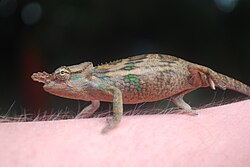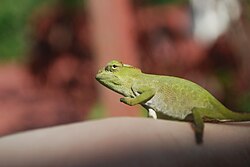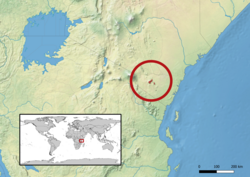Biology:Kinyongia boehmei
| Kinyongia boehmei | |
|---|---|

| |

| |
| Male above, female below | |
| Scientific classification | |
| Domain: | Eukaryota |
| Kingdom: | Animalia |
| Phylum: | Chordata |
| Class: | Reptilia |
| Order: | Squamata |
| Suborder: | Iguania |
| Family: | Chamaeleonidae |
| Genus: | Kinyongia |
| Species: | K. boehmei
|
| Binomial name | |
| Kinyongia boehmei (Lutzmann & Nečas, 2002)
| |

| |
| Synonyms[1] | |
| |
Kinyongia boehmei, the Taita blade-horned chameleon, Böhme's two-horned chameleon and Dwarf fischer's chameleon, is species of chameleon, a lizard in the family Chamaeleonidae, found only in the Taita Hills of southeastern Kenya.[2][1] It is the smallest species in the East African "two-horned chameleon" group and until 2008 it was generally considered a part of K. tavetana.[3][4]
Taxonomy and etymology
Kinyongia boehmei was first scientifically described in 2002, originally as a subspecies of K. tavetana.[3] In 2008, the taxonomy of the "two-horned chameleons" in Kenya and Tanzania was reviewed, which prior to the study only consisted of two recognized species, K. fischeri and K. tavetana. It was shown that boehmei is sufficiently distinct from K. tavetana to be recognized as a separate species, although the two are sister species.[4]
The specific name, boehmei, is in honor of German herpetologist Wolfgang Böhme.[5]
Geographic range and habitat
K. boehmei is found only in the Taita Hills of southeastern Kenya, at altitudes of 1,000 to 2,200 m (3,300–7,200 ft).[1] It occurs in the canopy of forests, as well as in patches of trees and bushes in subsistence farms.[2]
Appearance
K. boehmei is the smallest of the of "two-horned chameleon" group of Kenya and Tanzania. It is up to 18.6 cm (7.3 in) in total length, with the tail making up more than half of that. Females do not grow as large as males. Adult males have a pair of large, mostly parallel, flattened "horns" on the nose, whereas females essentially are hornless. The flattened shape of the male's "horns" separates it from male K. tavetana where they have a triangular shape. Both sexes of K. boehmei have several small elevated tubercles on the section of the ridge of the back (dorsal crest) nearest to the head, which are lacking in K. tavetana.[3][4]
Reproduction
K. boehmei is oviparous.[1] There are typically 2–11 eggs in a clutch.[3]
References
- ↑ 1.0 1.1 1.2 1.3 Species Kinyongia boehmei at The Reptile Database www.reptile-database.org.
- ↑ 2.0 2.1 Cite error: Invalid
<ref>tag; no text was provided for refs namediucn status 18 November 2021 - ↑ 3.0 3.1 3.2 3.3 Lutzmann, N.; Nečas, N. (2002). "Zum Status von Bradypodion tavetanum (Steindachner, 1891) aus den Taita Hills, Kenia, mit Beschreibung einer neuen Unterart (Reptilia: Sauria: Chamaeleonidae)". Salamandra 38 (1): 5–14. https://www.salamandra-journal.com/index.php/home/contents/2002-vol-38/441-lutzmann-n-p-necas/file.
- ↑ 4.0 4.1 4.2 Mariaux, J.; Lutzmann, N.; Stipala, J. (2008). "The two-horned chamaeleons of East Africa". Zoological Journal of the Linnean Society 152 (2): 367–391. doi:10.1111/j.1096-3642.2007.00332.x.
- ↑ Beolens, Bo; Watkins, Michael; Grayson, Michael (2011). The Eponym Dictionary of Reptiles. Baltimore: Johns Hopkins University Press. xiii + 296 pp. ISBN:978-1-4214-0135-5. (Kinyongia boehmei, p. 30).
Further reading
- Tilbury, Colin R.; Tolley, Krystal A.; Branch, William R. (2006). "A review of the systematics of the genus Bradypodion (Sauria: Chamaeleonidae), with the description of two new genera". Zootaxa 1363: 23–38. (Kinyongia tavetana boehmei, new combination).
Wikidata ☰ Q3197235 entry
 |


